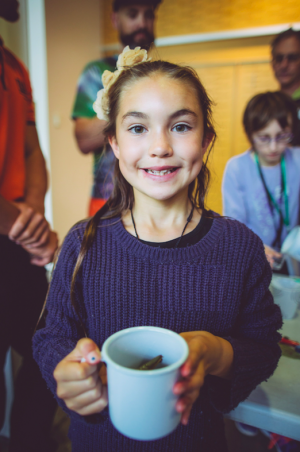Chef Charles Royal incorporates traditional Māori kai with modern cuisine. Check out Charles showing a visitor from the US the way brewing is done Aotearoa-style, with a dollop of mānuka honey: tu meke tea!
Brew up a storm with the ultimate homegrown tea made from native plant leaves, then get your parents or teacher to judge the results.
What to do
Your mission is:
Instructions

1. GOT YOUR ID?
Find a native tree that is fit-to-a-T for tea making in your garden or nearest park. Kawakawa is easy to recognize, but only grows as far south as Banks Peninsula. If you’re stewing in the south, you could swap kawakawa with horopito (try chewing horopito leaf raw: it’s hotter than a dragon’s burp!).
Only choose leaves that you know are safe to eat (check with an adult). Check out this list of poisonous NZ garden plants, and don't use them! If you're not sure = don't use! Got it?

2. BE-LEAF IN YOURSELF
Pick a handful of leaves. Don’t skip the leaves with the holes in them: kawakawa has its very only caterpillar taste-tester who only eats the best leaves so they have the seal of approval.
Other good leaves are mānuka and patē (aka seven finger). If you like you can go non-native and use herbs from your mum’s garden: mint, basil, rosemary, thyme, sage are worth a try.

3. MAGIC POTION MAKING
Get your leaves, mug and boiling water. Be like Harry Potter and mix your magic potion: add the leaves to the water.
Let your brew stew!
4. BREW AND IMPROVED
Most leaves should only need 5-10 mins to infuse in the hot water.
Then, give it a sip – what does it need?
Is it sweet-as how it is, or do you need to flava up your brew with some secret herbs’n’spices from your kitchen’s spice rack? Or there’s the ol’ classic slice of lemon and a spoonful of mānuka honey. Or go radical with some ginger.

5. TEA REFEREES
Present your brew to your tea party judging panel. Run a master-chef tea-brewing competition with a friend and get your parents or teacher to judge the results.
And remember to UPLOAD a photo of you with your brew to Wild Eyes and level up to make your avatar's eyes go WILDER!

WILD FACTOR
Take it even further and set up a stall on your street to see who can be the best kawakawa tea shopkeeper! Most sales wins!

PG TIPS!
K.I.S.S. (Keep It Simple Stupid): Then you’ll be able to taste the different flavours of the leaves.
What's happening?
DOCTOR OF TEA-OLOGY
Kawakawa has un-be-leaf-able superpowers and has long been in the rongoā medicine kete (kit bag). Rongoā are the traditional Māori ways of treating illness and disease, and kawakawa is used as part of treatments for everything from toothache to sore muscles. Check out more about rongoā here.
Kawakawa leaves are also used for head wreaths (pare kawakawa) worn in the time of mourning death.

– Kawakawa spotting
ROYAL TEA
TEA-LOFA!
Kawakawa is traditionally used to treat toothache: it's a mild sedative (i.e. it makes your tongue a bit numb). Kawakawa is the cousin of kava, the root of which is brewed up in the Pacific: Tea-lofa!
SCIENCE SAYS: KA PAI KAWAKAWA!
When he was still at Howick College, award-winning young scientist Chris Ryan researched the use of kawakawa as medicine and proved that its power came from the way it was prepared as part of rongoā. His combo of fresh science with traditional tikanga (aka customs) showed what the locals have known for ages: the kawakwa leaf is super powerful. Ka pai Chris, you deserve a cuppa!

– Science + rongoā = totes tea-mendous
Inspiration
BEAR WITH IT
Adventurer Bear Grylls is a big fan of a brew-up. “A cup of tea solves a lot of problems. I like a bit of spruce or pine-needle tea. For President Obama I brewed catnip tea. Anywhere you go in the wild you’d be able to make tea.”
Would he prefer your kawakawa or horopito tea or do you reckon he'd go for his own poo brew (see below)?
BEAR'S POO BREW: TEA LICIOUS?
We know Bear likes a cuppa, but we're not sure he would've got President of the United States Barack Obama drinking this tea: made from Dassie dung!
PEPPER WITH YOUR TEA M'AM?
Kawakawa is a member of the pepper tree family. Nibble on a leaf and your tastebuds will tell you why!
BUG OFF = THE BUSINESS!
Fourteen-year-old Palmerston North Girls' High School pupil Zoe Glentworth made an insect repellant from kawakawa. Her school science research project was recognised by the Royal Society and she has gone into business! Just goes to show what self be-leaf and science can achieve!





























